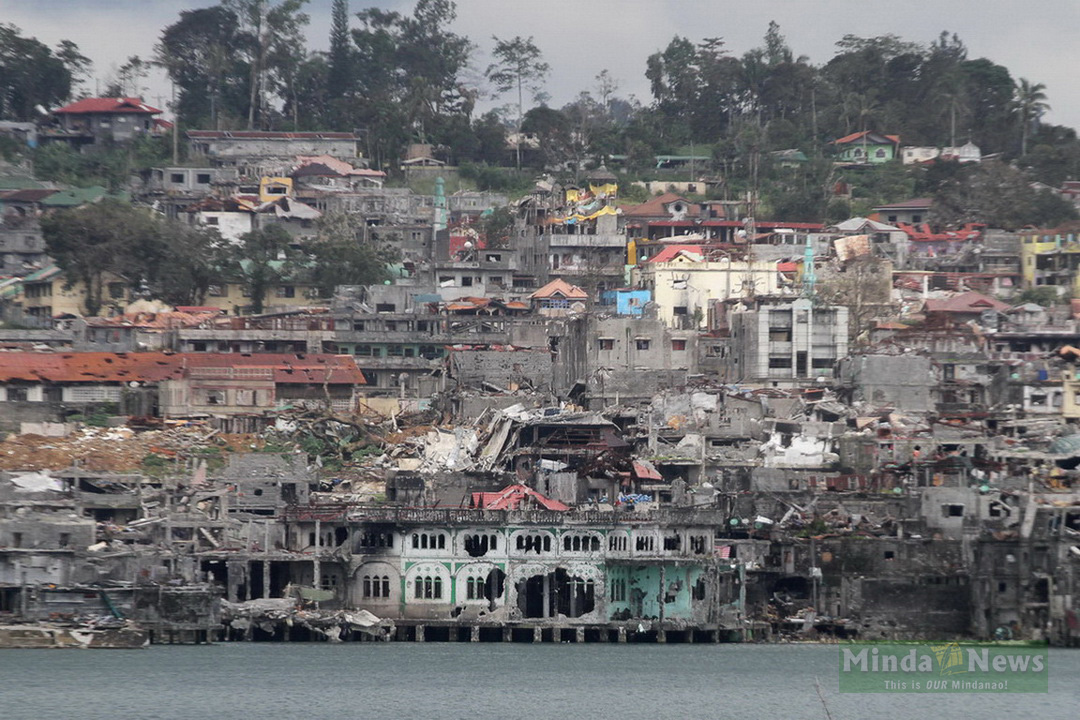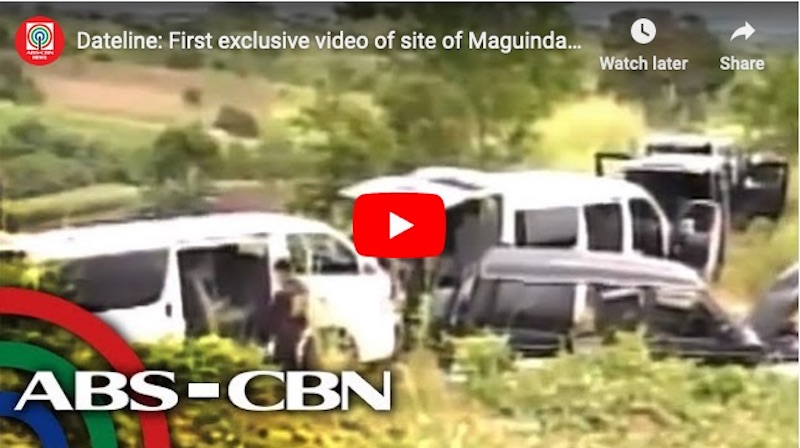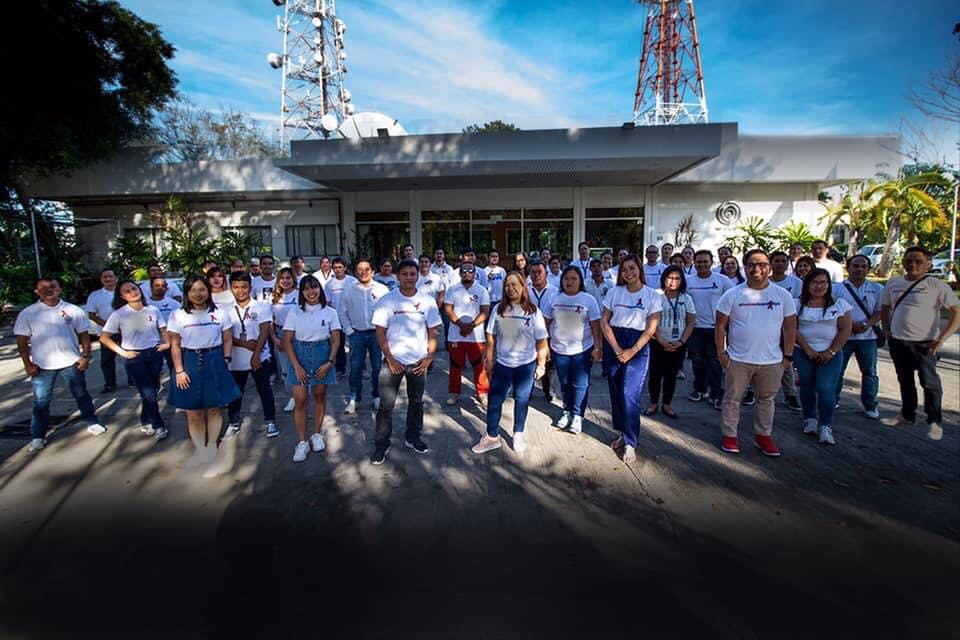1st of two parts
DAVAO CITY (MindaNews / 30 August) – Name any major news event in Mindanao that made it to the national headlines in the past three decades and you can be sure ABS-CBN’s indefatigable television and radio reporters in the cities of Davao, Cagayan de Oro, Cotabato, General Santos and Zamboanga and correspondents in other areas across Mindanao’s 27 provinces and 33 cities were among the first responders, braving bullets, bombs, wars, mass evacuations, terrorist attacks, kidnappings, ambuscades, floods, typhoons, fire, landslides and earthquakes to bring you the news. Or capturing in vivid colors the celebration of fiestas, street parades, art exhibits, trade fairs, inauguration of bridges, roads and new landmarks, homecomings of champions, peacebuilding efforts, elections and inaugurals, turnover rites, protest rallies, tourist destinations, environmental concerns, triumphs and defeats.
From 1988 in Davao City, 1995 in the cities of Zamboanga, Cagayan de Oro and Pagadian, 1998 in General Santos, 1999 in Cotabato City, ABS-CBN in Mindanao’s morning shows Mondays to Fridays would give viewers and listeners a recap of what happened the day before, tackle issues that matter in the communities they serve — in the language best understood in the area — and by 5 p.m. provide a recap of the day that was and what to look forward to the next day or the next week via the local TV Patrol newscasts, a prelude to the national TV Patrol.
 From Maayong Buntag Mindanao FB page
From Maayong Buntag Mindanao FB page
Effective Monday, August 31, Mindanawons will no longer wake up to Maayong Buntag Mindanao, Pamahaw Espesyal, Buenos Dias Zamboanga, and Magandang Umaga South Central Mindanao, the Monday to Friday program from 6 to 6:30 a.m., not even online as has been the stations’ platform since the National Telecommunications Commission ordered the network on May 5 to cease and desist from operating as its franchise had expired. In an earlier congressional hearing, the NTC chief had vowed the network would be able to operate while the franchise renewal was pending in Congress, as has been the practice with other franchise applicants.
At 5 p.m., on Monday, there will be no more newscasts to look forward to as ABS-CBN’s TV Patrol in Mindanao and the other regional TV Patrols nationwide under the ABS-CBN Regional Network Group, aired their final episodes on Friday, August 28, the first media casualty in the time of COVID-19 that does not trace its demise to the pandemic but to politics.
8 out of 10 Mindanawons for grant of franchise
ABS-CBN network signed off on May 5 following the NTC’s cease and desist order but continued to air its shows and newscasts via the network’s digital platforms.
Out of 84 members of the House Committee on Legislative Franchises, House leaders and ex-officio members who voted on the franchise on July 10, 70 voted to deny despite the testimonies of officials from various government agencies that the network violated no law. Eleven voted for its renewal, two abstained and one inhibited.
Out of the 84, 17 were Mindanawons, 14 of whom voted to deny while three, including a Vice Chair of the Committee, voted for the grant of the franchise.
 Of 84 representatives who voted on the fate of ABS-CBN on Friday, 17 are Mindanawons.
Of 84 representatives who voted on the fate of ABS-CBN on Friday, 17 are Mindanawons.
Fourteen of the 17 voted “yes” to the resolution “denying the franchise application of ABS-CBN Corporation to construct, install , establish, operate, and maintain radio and television broadcasting stations in the Philippines” while three voted against rejecting the franchise bid. MINDANEWS
The denial of the franchise marked the beginning of a series of retrenchemen programs, including the regional stations which will shut down by end of office hours on Monday.
A day after the July 10 voting, the Social Weather Stations (SWS) released a report on its survey conducted on July 3 to 6 showing that 75% of adult Filipinos nationwide believed Congress should renew ABS-CBN’s franchise, with Mindanao – President Rodrigo Duterte’s strongest support base — registering the highest support for ABS-CBN’s franchise bid at 80% or 8 out of 10 Mindanawons.
Results of the SWS’ National Mobile Phone Survey also showed that 56% nationwide agreed that the non-renewal of the franchise of the country’s largest broadcast network is a major blow to press freedom. In Mindanao, home to Duterte, the country’s 16th President and the first Mindanawon to lead the nation, 57% agreed.
Duterte, early on in his administration, had criticized ABS-CBN for allegedly failing to air his election campaign advertisements but airing then Senator Antonio Trillanes’ campaign ad against him days before the May 9, 2016 polls He threatened to sue the network for estafa, warned its franchise would not be renewed and in December last year, urged its owners to just sell the “Kapamilya” (Family) network.
The network had explained that its ads were on a first come-first served basis and Duterte was just one among many national candidates whose ad placements were not aired.
 Mayor Rodrigo Duterte in Gikan sa Masa, Para sa Masa, 20 July 2014 episode over ABS-CBN Channel 4 Davao.
Mayor Rodrigo Duterte in Gikan sa Masa, Para sa Masa, 20 July 2014 episode over ABS-CBN Channel 4 Davao.
For 17 years – from 1998 until 2015 — Duterte, was himself a “Kapamilya” star, appearing every Sunday morning in his television show, “Gikan sa Masa, Para sa Masa” (From the Masses, For the Masses), a blocktime program aired over ABS-CBN Davao (later renamed ABS-CBN Southern Mindanao), a television station with a regional reach, heard simultaneously over the network’s radio station DXAB and written about by reporters of local and national newspapers.
Mindanao history, Philippine history
The list of stories the ABS-CBN teams in Mindanao reported on in three decades is a very long list and includes Duterte’s reign as mayor of Davao City for 22 years and 32 of his 34-year political career, his controversial ‘war on drugs’ while serving as mayor, his “listening tours” in 2014 and 2015 in preparation for his Presidential bid, his election campaign sorties, his election as President and his many visits across Mindanao as the country’s chief executive and commander in chief.
 Buildings lay in ruins after the five-month battle to retake Marawi City from ISIS-inspired terrorists. Photo taken 24 October 2017. MindaNews photo by MANMAN DEJETO
Buildings lay in ruins after the five-month battle to retake Marawi City from ISIS-inspired terrorists. Photo taken 24 October 2017. MindaNews photo by MANMAN DEJETO
That very long list also includes, to cite a few, the coverage of the African Swine Fever outbreak in Davao Occidental and parts of Davao City in early 2020 followed by COVID-19; plebiscite and inauguration of the Bangsamoro Autonomous Region in Muslim Mindanao in 2019; Jolo Cathedral bombings in 2019; investment scams in 2019 and 2012; martial law in Mindanao from 2017 to 2019 and in parts of Central Mindanao for a week in December 2009; Marawi Siege in 2017; forest fire at the foothills of Mt. Apo in 2016; Davao bombings in 2016, 2003, 1993; Mamasapano Tragedy in 2015; installation of Mindanao’s first Cardinal in 2014; the celebrations during the signing of the Comprehensive Agreement on the Bangsamoro between government and the Moro Islamic Liberation Front (MILF) in 2014; Zamboanga Siege in 2013 and 2001 involving the Moro National Liberation Front (MNLF); Super typhoon Pablo in 2012; Typhoon Sendong in 2011; Ampatuan Massacre in 2009; war and mass evacuations in the aftermath of the aborted signing of the 2008 Memorandum of Agreement on Ancestral Domain between government and the MILF; Air Philippines’ crash in the Island Garden City of Samal in 2001; all-out war against the MILF in 2000 waged by President Joseph Estrada and the 2003 war waged by President Gloria Macapagal-Arroyo; the “pulbusin ang Abu Sayyaf hanggang maging abo” war in Sulu waged also by Estrada in 2000; Cebu Pacific crash in Misamis Oriental in 1998; arrival of Nur Misuari in Zamboanga City after the signing of the Final Peace Agreement between government and the Moro National Liberation Front in 1996; Ipil Massacre of 1995; Sitio Rano Massacre in Digos City in 1989; hostage-taking at the Davao Penal Colony in April 1989 and in a police camp in Davao City in August that same year where an Australian missionary was killed and became the subject of Presidential candidate Duterte’s rape joke in April 2016.
Add to that the kidnappings, massacres, bombings, vigilante killings in various parts of Mindanao; summary executions by the Davao Death Squad and its copycats in other areas; the terror attacks of the Abu Sayyaf, Bangsamoro Islamic Freedom Fighters, Maute Group; war on drugs, corruption, man-made and natural disasters and the everyday concerns of the communities the stations serve.
Although the network usually sends Manila-based reporters to cover major events, reporters from the regions are the frontliners, the first responders, the first to break the news.
And even as Manila-based reporters come and the local reporters end up doing sidebars, their stories are as valuable as locals have the distinct advantage over their national counterparts for knowing the territory, personalities and dynamics in their respective areas and for speaking their language.
And when the Manila-based news personalities leave, local reporters continue to follow-up the story and update their respective communities and the nation.
First visuals
A shocked nation watched the first visuals of the November 23, 2009 massacre in Ampatuan, Maguindanao from ABS-CBN in Cotabato City. The Cotabato and General Santos news teams, even those in Davao, diligently followed the story on the massacre of 58 persons, 32 of them from the media, and provided updates long after the Ampatuans were arrested and long after the Manila-based news team left. Every year, the local news teams covered the anniversary and the final verdict in December last year.
 Frist video footage of the the massacre site in Ampatuan, Maguindanao. on November 23, 2009. Photo from ABS-CBN News website
Frist video footage of the the massacre site in Ampatuan, Maguindanao. on November 23, 2009. Photo from ABS-CBN News website
To the disappointment of many, among those who voted to deny ABS-CBN’s franchise was Maguindanao Rep. Esmael Mangudadatu, whose certificate of candidacy for governor was the reason why the convoy of relatives and the media were travelling to Shariff Aguak that day in 2009, to file it at the Commission on Elections’ provincial office.
In 2015, ABS-CBN Cotabato also gave the nation the first glimpses into what happened in Mamasapano, Maguindanao.
ABS-CBN North Mindanao gave viewers the first video footages in the aftermath of typhoon Sendong in 2011 as did ABS-CBN Southern Mindanao for super typhoon Pablo in 2012.
ABS-CBN in General Santos followed boxing sports icon Manny Pacquiao’s rise in the boxing and political arenas and his homecomings from his world championships.
For ABS-CBN reporters in Zamboanga City, the Zamboanga Siege of 2013 was a “non-stop coverage,” recalls Queenie Casimiro, News Chief of ABS-CBN Zamboanga.
 Queenie Casimiro (6th from L), News Chief of ABS-CBN Zambonaga, and her team. Photo courtesy of ABS-CBN Zamboanga
Queenie Casimiro (6th from L), News Chief of ABS-CBN Zambonaga, and her team. Photo courtesy of ABS-CBN Zamboanga
“Flights were cancelled as the flight path of commercial planes would pass through the areas where the gunbattle was happening. Thus, Manila teams were not able to reinforce us immediately. But teams from Davao and Cagayan de Oro arrived towards the end of the first week. It was a non-stop coverage. We filed stories across platforms starting with Umagang Kay Ganda until dawn the next day for ANC (ABS-CBN News Channel),” Casimiro told MindaNews.
ABS-CBN Zamboanga Channel 3 aired TV Patrol Chavacano from 5 to 5:30 p.m. Mondays to Fridays, the same time slot for TV Patrol Southern Mindanao in Davao City, TV Patrol North Mindanao in Cagayan de Oro and TV Patrol South Central Mindanao in General Santos City.
Checkpoints, Ambush
A team from ABS-CBN in Northern Mindanao slipped past the military cordon in 2000 and got chased by the men of Abdullah Macapaar alias “Kumander Bravo” of the MILF in Kauswagan, Lanao del Norte. “The team was relieved that Kumander Bravo only wanted an interview. Continuous coverage raised awareness on the plight of the communities affected by the conflict,” News Chief Prospero Jean Dela Pena told MindaNews.
Dela Pena recalled yet another incident in 2000 where its news team was with a police team that would serve a warrant of arrest but was attacked by Tadtad cult members in Pangantucan, Bukidnon. At least 20 members were killed. The cameraman was asked to testify at the Senate hearing. “As a result, the policemen involved in the operation were exonerated,” he said.
 Station photo shoot during the start of the hearing in Congress. Photo courtesy of ABS-CBN North Mindanao.
Station photo shoot during the start of the hearing in Congress. Photo courtesy of ABS-CBN North Mindanao.
Before May 23, 2017, Day 1 of the Marawi Siege, the news team of ABS-CBN Northern Mindanao had been reporting on violent incidents involving “black flag mmbers” in Marawi. On December 26, 2015, its team from Iligan was ambushed by motorcycle-riding gunmen in Bangolo, Marawi City.
The news team was also the first to report on the trash from South Korea that was shipped to Tagoloan in Misamis Oriental. Dela Pena said their coverage helped pressure government to ship back the trash to Korea.
Casimiro recalls an incident during the arrival of a freed kidnap victim at the helipad of the Western Mindanao Command. The information officer had given the reporter the go signal to proceed to the helipad but arriving there, a relative of the freed victim objected to the media’s presence. “When our reporter insisted that he had permission to be there, the relative punched our reporter on the face.”
Quick deployment
Because the stations belong to a giant network and they are spread in strategic areas in Mindanao, news teams can easily be deployed to where the stories are. In disasters for example, the presence of ABS-CBN, the dominant TV network in Mindanao, assures local governments and victims that help is on its way.
The quick deployment to find out what happened is easily done because the stations have vehicles and funds to send a team or even teams, to cover. Community papers and radio stations do not have these resources.
Having the widest reach across the region and across Mindanao, ABS-CBN reporters are always the favored ones by politicians, military officials, the business sector, civil society and other sectors. Activities or press conferences would sometimes suffer delays if its news team is not yet in the venue, a fact that other reporters had learned to live with.
Exposure on television via ABS-CBN in Mindanao has helped advance the careers of many, promoted business and advocacies, and boostd education and public health campaigns. How to avoid dengue, getting vaccinated against polio and more recently, how to deal with COVID-19 are just some of the campaigns quickly amplified via TV and radio.
Even the Department of Health (DOH) and Department of Education (DepEd) in the regions acknowledge the local stations’ valuable help in their campaigns, particularly because – before the network’s franchise was denied – they could quickly reach out to their constituents, even in the remote areas in Mindanao, via Free TV and radio. (Carolyn O. Arguillas / MindaNews)
